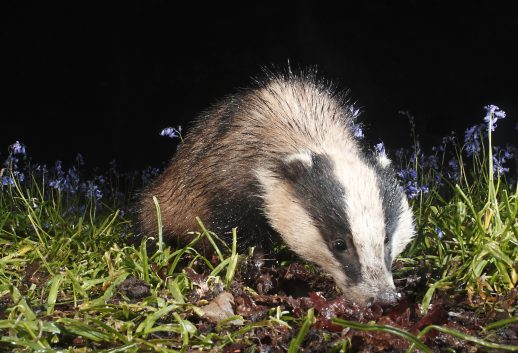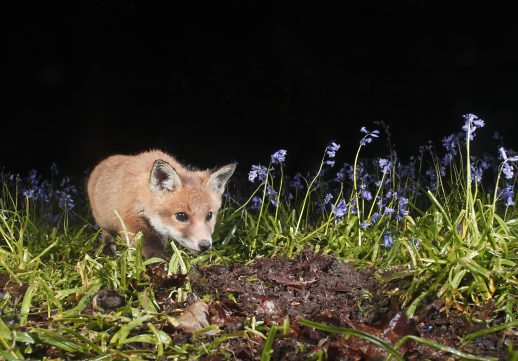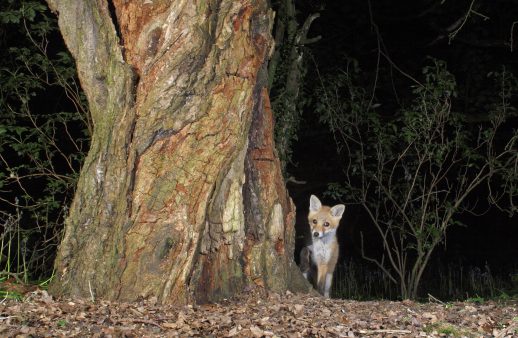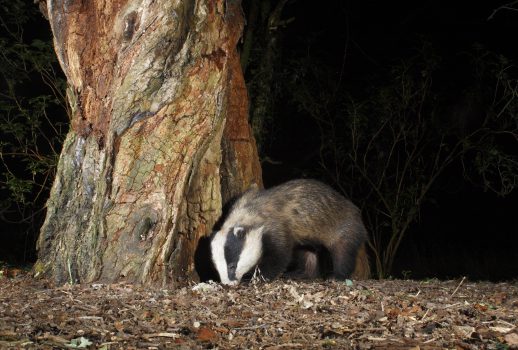
Words and pictures: Mat Bingham
I was struggling to keep my fingers and toes warm. Inhaling the crisp cold air was painful as we talked about the process upgrade at Frankley water treatment works. I was distracted from the discussions about chemical dosing systems and the relative merits of Type 316 stainless steel over concrete by the trees that loomed over us. We were stood on the water treatment works access road, the oak bowers blotting out the weak winter sunshine.
On OS maps the trees are marked as an ancient woodland called Cutlers Rough. Relatively undisturbed, it is an isolated pocket of habitat, about an acre, surrounded on all sides by one of the largest water treatment works in the country.
I stayed late one night to investigate the woods. Walking along the access road I could hear the drone of the motorway several miles away and the rattling 2-stroke engines of the local youths riding motorbikes in a nearby park. Closer to the woods a blackbird sounded an alarm call as it darted for cover and a green woodpecker, laughing from above, hid in the trees.
A mistle thrush landed on the manicured grass that surrounded a storage tank. He stared at me, tilting his head slightly. I think he must have been curious about the fluorescent jacket I was wearing. A muntjac deer (the barking deer), caught my attention as it darted across the road, disappearing from view. My gaze returned to the mistle thrush but he was gone.

A wall of tangled brambles marked the border between the access road and the wood. I fought my way in, coat continually snagging on thorns as I stumbled on the uneven ground, a mixture of rocks and old tree stumps. The brambles finally loosened their grip and I entered the wood. The floor was carpeted with leaves slowly turning to mulch in the damp conditions. It smelt earthy. In the centre there was an area of disturbed ground, mounds of soil and dark damp holes, the entrance to a subterranean world. Badgers.
Over the following months I would often visit the wood, winter’s grasp finally let go, and green shoots started appearing through the carpet of leaf litter. I knew the woodland floor would be covered in bluebells in a couple of months. The badgers were becoming more active, venturing above ground, I didn’t see them but I knew they were there after dark. I would sometimes leave peanuts which disappeared before the following morning. There were signs they had been dragging fresh bedding into their sett: a trail of leaves formed a green path over the freshly dug earth leading to the entrance.
The air was heavy with the scents of spring. I could also smell fox. The process controllers who work the night shift told me they had occasionally seen foxes on the CCTV cameras. Somewhere in the wood there was a fox family.

I started work on a remote camera system that I could leave overnight in the woods. It took longer than expected. I rejected the idea of using an off-the-shelf trail camera early on in the project as it did not offer the freedom to change the lighting or the infra-red sensor position I desired. So I built my own. There were lots of teething problems; finding a remote trigger for the camera that was reliable proved to be difficult. I trialled several before finally settling on a sensor which I had to import from America. The other main problem was lighting – the flashgun batteries drained within a few hours in cold weather so I needed more power. I tried out a few ideas and decided to rewire them to six volt batteries I bought from an online electrical store. On testing, these larger batteries remained charged for several days. With a bit more tweaking the system worked perfectly. I set up a final trial in a field near my home overnight and someone stole everything. They left me the smashed camera housing as a parting gift. The insurance company refused to pay out but I was determined to carry on. I started again and rebuilt the system. Finally I was ready to set it up in Cutlers Rough.
I didn’t want the animals of the wood to become too reliant on the food I left for them so I would only feed them a couple of times each week. It took about an hour to set up and test the camera each night and I retrieved the equipment first thing in the morning when I arrived at work.

The night shift at the water treatment works thought I was a bit eccentric and started to call me Badger Man. But over time they became interested in the comings and goings of the animals. Each time I headed up to the control room to let them know I was going to set up the camera that night they were keen to talk to me about what the badgers had been up to and they wanted to look at my pictures. They saved my website as a favourite on their internet browser alongside the controls for the water treatment works.
Visiting the wood one lunchtime I was stood on an animal trail near the badger sett. There was a new entrance – the badgers had been really busy digging overnight. I crouched down to get a better view and as I looked at their handiwork a black and white striped head appeared out of the darkness of the entrance hole. It was the sow. She sniffed the air and then left the sett shuffling towards me along the trail. The badgers knew my scent and were getting used to me. She stopped a meter away from me, and lifting her head, she sniffed the air again. I didn’t move, and for a moment I was eye to eye with the badger. Then, she turned, and headed back underground. Reluctantly I headed back to work.
I still set the camera up each week and plan to do so at least until the autumn.

See more of Mat’s stunning wildlife photography on his website